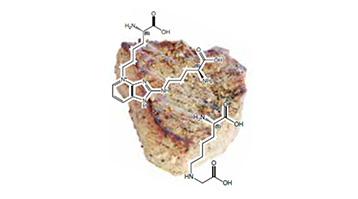Welcome to Iris Biotech
For better service please confirm your country and language we detected.

For better service please confirm your country and language we detected.

Thank you very much for your interest in our products. All prices listed on our website are ex-works, Germany, and may attract customs duties when imported.
You may/will be contacted by the shipping company for additional documentation that may be required by the US Customs for clearance.
We offer you the convenience of buying through a local partner, Peptide Solutions LLC who can import the shipment as well as prepay the customs duties and brokerage on your behalf and provide the convenience of a domestic sale.
Continue to Iris Biotech GmbHSend request to US distributorPublished on 26.04.2016

Proteins contained in meat and other comestible goods are usually rich in the amino acids arginine and lysine. The side chain functional groups of Arg and Lys react with reducing carbohydrates such as glucose or lactose to form Amadori reaction products. These characteristic intermediates decompose particularely at elevated temperatures to various Maillard reaction products (MRPs) which are responsible for the distinctive flavours of many food products. MRPs are widely used as markers for the nutritional quality of food and have gained broad attention in cosmetics, biochemistry, food, and pharma industry.

MRPs reduce the availability of essential amino acids such as arginine and lysine in food, and therefore influence their nutritional quality. They are responsible for deterioration of food during storage and processing. From a pharmacological point of view they may cause kidney damage and show carcinogenic, but also antiallergenic, antibiotic, anti-mutagenic, and antioxidant properties.
References